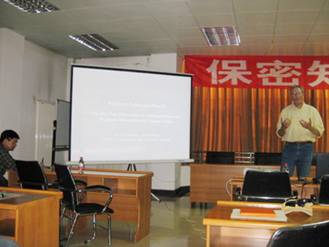|

|
|
(Prof. Madsen giving a lecture. Photo/RCL) |
US professors, David B. Madsen, David Rhode and P. Jeffrey Brantingham, as well as their three postgraduates, from University of California at Los Angeles (UCLA) visited ISL for an exchange lasted from 12th June to 9th July 2010, at the Invitation of Research Prof. LAI Zhongping.
Profs. Rhode, Madsen and Brantingham, together with Dr. HOU Guangliang, from the Department of Geography Qinghai Normal University, respectively gave four lectures, titled (1) Packrats, Pollen and Pine I: Midden Evidence for Vegetation History in Northwest Colorado, (2) Packrats, Pollen and Pine II: The Flat Tops Pollen Records and Implications for Regional Millennial-scale Climate Cycles, (3) Did Modern Humans Evolve in China, and (4) The Relationship Between Environmental Evolution and Prehistoric Culture of Eastern Qinghai.
In his report, Rhode recounted that there still retained some packrats animal lairs since the Holocene Epoch in caves of Colorado, United States, in which the animal dung and plant tungguls that animals left when they nested their grounds glued together and were reserved till now. Through the chemical dating of the plant tungguls and the analyzing of the sporopollens, we can find out the evolutionary process of vegetation from different periods and areas, and its space migration, as well as the relation with the climate.
Madsen told about the record of sporopollens uncovered in the drillhole cores of Grizzly Lake at Colorado. Based on the varying ratio between land spruce and pine sporopollens, the regional vegetation and climatic evolutions in a scale of thousand years and scale of thousand years in the region since the Holocene Epoch were recreated.
Brantingham narrated the evolution of modern Chinese people and analyzed the evolutionary process of human from the aspect of gene and archaeology, including chronology and morphological features of stoneware.
|

|
|
(Joint field study at Qaidam Basin. Photo/RCL) |
Hou Guangliang gave an account of the relation between environmental evolution and the prehistoric culture of the east of Qinghai. He concluded that the cold climate event happened about 4000 years ago had changed the culture of eastern Qinghai: (1) the prehistoric culture decayed and shrank to the southeast; (2) the mode of production began to change; (3) the society disintegrated and marched toward multicultures. The audience includes some research staffs and students of ISL, and postgraduates from Northwest Institute of Plateau Biology, CAS and Qinghai Normal University (QHNU).
The US visitors, Dr. Hou and some members of Prof. Lai's research group made a joint investigation at Qinghai Lake and Qaidam Basin.